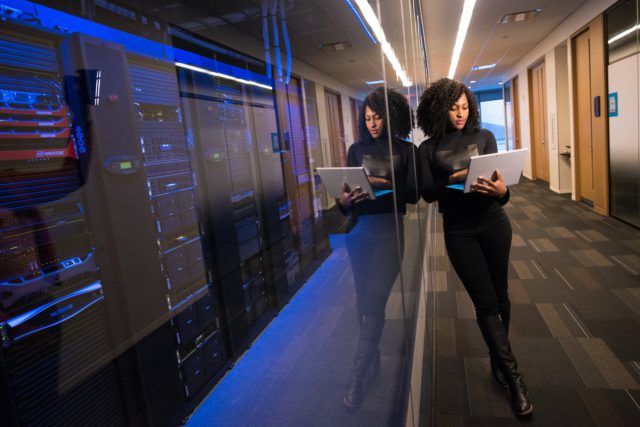“Not a day passes for me without seeing the many ways in which digital technology can advance peace, human rights and sustainable development for all”, António Guterres, Secretary-General of the United Nations
Covid-19 has urged humanity to reconsider many of its ways regarding the planet. Images of the way the planet started healing during lockdown flooded every screen, outlining more than ever the need for change. Green technology is on the rise along with innovative digital transformation. And while being sustainable before the pandemic was a “nice to have” element for businesses, after the pandemic going sustainable has become a necessity. It is safe to say that an environmentally sustainable workplace is more relevant than ever.
Related: The Power Of eLearning: Is That Good For Environment?

Definitions
There are countless definitions for “Sustainability”, the most relevant one is the one published on the Economist Intelligence Unit 2008 research “Doing Good: Business and the Sustainability Challenge”. This study defines “Sustainability” as
“… those policies and processes which enhance the financial, environmental, societal, human, and other resources on which the company involves depend for its long-term health. Sustainability is the result of having such sustainable policies and processes, and aligning them so that goals in one area are not compromised in favor of those in another.”
The term “Sustainable Workplace” is referring to a situation that balances the planet, people, and profit to produce success and viability in the long term. So a business will be regarded as unsustainable if it fails to safeguard the health, safety, and welfare of its employees.
The Benefits
Going green is not only for the benefit of the environment. It’s also beneficial and cost-reducing for every business in the long term. Technology has irrevocably changed the way business is conducted and is contributing to battling climate change. An insight many have realized until now is that, although sustainability is no magic carpet to prosperity, attention to sustainability is consistent with, and may cause, higher share price growth and profits. The companies that adopt the highest number of sustainability policies have marginally better profits than their peers. It seems that nowadays quality matters more than quality.
Use Technology to your Advantage
The majority of business pioneers are already investing in cutting-edge technologies to drive business development and maintain their competitive edge. Deciding to adopt sustainability in the workplace is a decision that will prove to be significant for the future of your business. Conducting research is a crucial part of the process, and TrustMyPaper can help you gain inspiration in which ways you can invest in technology for a more sustainable workplace. Here are some ideas
Reduce Energy Consumption
Reducing your energy or switching to renewable energy has a direct positive impact on the environment. CO2 emissions are reduced when you use less energy. Aside from utilizing natural light wherever feasible, a series of current technologies such as control stations and light sensors are an excellent approach to transition to more sustainable work environments.
Keep track of interior controlled capacity such as air conditioning, heating, and even the brightness of your computer screen to decrease the amount of energy you consume. While they may look insignificant in the grand scheme, if every business implemented the adjustments, it would help to dramatically reduce energy use and contribute to a more cost-effective, less wasteful future.
Second-Hand Equipment
Where reasonable, make greener shopping by renting or leasing apparatus rather than obtaining them. This implies less utilization of common assets and a decrease in production. If possible, buy second-hand hardware that’s essentially effective and in great condition. Persuade employees to recycle and teach them where items ought to be dropped within the containers. Moreover, you can buy eco-friendly paints, office supplies, cleaning items, furniture, and decor. This could emphatically create quality air and improve the workspace.

Virtual Conferences
Rather than arranging face-to-face meetings with customers or accomplices, you can organize webinars. This spares exertion, time, and other assets (for instance fuel, energy, and water, etc.). This action guarantees the participation of more people, particularly if the people involved are living in completely different areas.
Adopt a Hybrid-Work Policy
The pandemic has heightened several trends in the workplace. Remote work is one of the most significant ones. The term “Hybrid Work” indicates a situation where the employee has the choice for one or two days to work from home. This is a direction many modern businesses will head into in the future. Should you follow their lead, consider investing in a digital workspace that provides your business with employee insights regarding their performance away from the office.
AI for Consuming Less Energy

AI and machine learning have revolutionized sustainability processes and are leading the way into new, advanced methods in which humankind can preserve energy and resources. A great example and a pioneer in the development of machine learning technology is Google. Google is successfully utilizing AI to diminish energy outflows from their information centers for the last couple of years. The company is additionally utilizing machine-learning calculations to saddle the control of wind energy by foreseeing wind energy output up to one day and a half in advance and conveying optimal delivery updates every hour to the control grid. Google reports that
“machine learning has boosted the value of our wind energy by roughly 20 percent, compared to the baseline scenario of no time-based commitments to the grid.”
Save Resources by Minimizing Risk
In the past, many companies had to make decisions having little data on their assets. The repercussions of these decisions ended up a waste of resources and raw materials that will stay in the environment for many years. New cutting-edge technologies can predict whether it is safe to invest in an industry, a particular area, or at a particular time by analyzing data and conducting elaborate reports. Companies like Jupiter Intelligence and AT&T are using supercomputers to analyze climate change and wildfire risk to inform business decisions. Using these services can ensure the safety of your employees and the minimum waste of resources.
Another digital development that can further assist in minimizing risk is electronic tagging. Companies can start to harvest data about demand, usage, and the life cycle of products for the benefits of a circular economy.
Supply Chain Management
A sustainable and well-built supply chain is a critical component of ensuring a long-term business. Design your supply chain to highlight inefficient operations and methods to replace them with more environmentally friendly alternatives. Collaborate with vendors to implement environmentally friendly business practices. One of the factors for picking new suppliers should be sustainability. Use raw resources instead of materials that contain hazardous chemicals like mercury, lead, or cadmium. Make use of recycling alternatives as much as possible.
Circular Economy
The circular economy has been around for a while. The term is referring to a sustainable product life process where preserving the environment and contributing to social life is at the business benefit. Many tech companies have adopted circular economy processes. From the production phase to disposal, to packaging and transfer, sustainability is a top priority. A common practice is reusing and recycling product parts and raw materials as much as they can, and striving to eliminate the usage of dangerous chemicals. Smart packaging solutions are also put into place with biodegradable materials. Another beneficial and educative process that tech companies have adopted are the return policies where costumers can voluntarily return their purchases after their usage is over for them to be broken into parts and incorporated into a new product life cycle.
Invest in your Community
A sustainable workspace is not only sustainable in the ecological sense. A sustainable workplace has also employee needs in the equation. Having that said, building a healthy community of cooperation and trust is vital for a sustainable workplace. Find ways to connect by organizing activities like having lunch together. Nurturing a sustainable culture between your employees is also crucial. Commuting is one of the most significant actions an individual can make to actively reduce CO2 emissions. Urge your employees to adopt a more eco-friendly lifestyle.
Conclusion
The dominance of the evidence is showing that sustainability is no longer just a trend. Contemporary businesses can no longer manage to approach sustainability as an element that boosts their likability or as a solid function isolated from the production process. The business companies that will intentionally incorporate circular economy and sustainability into business strategy will drive the future of innovation and cause loyalty from employees, customers, suppliers, communities, and investors. At last, businesses have a leading role in the sustainability bet; they are more than just ensuring long-term profit. Ensuring that operations will successfully continue in the long term is a priority that every business should take seriously.
BIO: Nicole Garrison is a content strategist, writer, and contributor at SupremeDissertations. She is a dedicated and experienced author who pays particular attention to quality research. Nicole consistently attends different courses, seminars, and conferences that keep her knowledge up to date. In her free time, Nicole is a passionate runner and traveler.
Read more:
